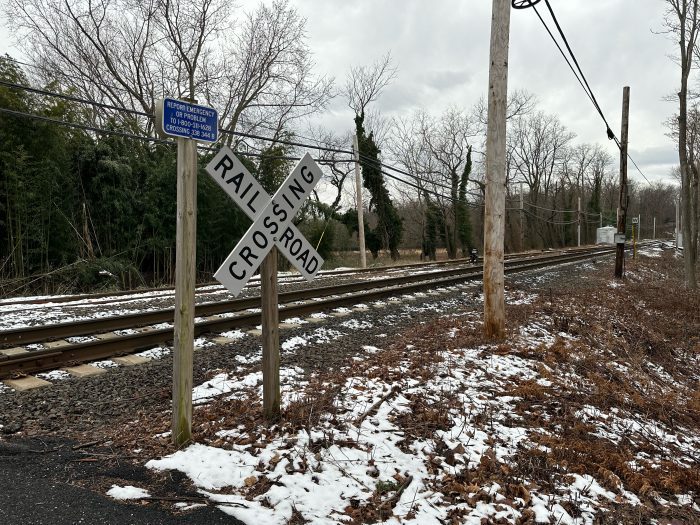Proposed housing plan packs room at civic meeting

By Lynn Hallarman
Monday night, Jan. 8, members of three civic associations — Port Jefferson, Port Jefferson Station/Terryville and Three Village — gathered to hear the case for a proposed residential housing complex adjacent to the Long Island Rail Road tracks in Port Jefferson Station.
Hauppauge developer Jim Tsunis, managing member of Northwind Group, in front of a crowded room at the Port Jefferson Free Library, reviewed the architectural plans and concept renderings for a 48-unit multifamily development to be located on 5.6 acres of fallow farmland at 16 Baylis Ave. known as Brook Meadows. The site plan includes a clubhouse, outdoor recreational areas, a playground, barbecue pits and parking. All the units are to be two-bedroom rental apartments with eight units set aside for affordable housing.
Ana Hozyainova, president of the Port Jefferson Civic Association, moderated the discussion. Approximately 20 audience members spoke for and against the proposed development. Present at the meeting as observers were Brookhaven Town District 1 Councilmember Jonathan Kornreich (D-Stony Brook), Suffolk County Legislator Steve Englebright (D-Setauket) and the recently appointed chairman of the Village of Port Jefferson Planning Board, Ray DiBiase.
Tsunis’ site application, reviewed by the Suffolk County Planning Commission, requesting a zoning change from light industrial to residential was disapproved in October. The Brookhaven Town Planning Board will then consider the commission’s recommendation in their deliberation about the zoning change. No final decision has been made to this point in time.
The overarching concern noted by the commission in their report was the placement of a dense residential community among several industrial properties, including proximity to the former Lawrence Aviation Industries site. The Monday night civic meeting focused on allowing community members to voice their concerns and review those cited by the commission directly with Tsunis.
Lively discussion
Comments from the audience were predominantly about the big-picture impacts of the project on the surrounding communities, with traffic issues as the number one concern. Several residents pointed to already glutted roadways around the proposed development and intolerable spillage into neighboring residential streets of commuters, trying to find a way around a backup.
“In the last five years, you can wait through three lights if you were on Sheep Pasture Road before you get through,” Port Jeff village resident Suzette Smookler said.
Another longtime Port Jeff resident, Mary Negra, received loud applause for her statement about the cumulative impacts of multiple housing projects over the past few years on the overall quality of life in the village.
“Every development adds another burden, and the layer of burdening has become untenable,” she said.
A flash point for Port Jeff civic members has been the exit and entry route to the proposed development. The access, which crosses the railroad tracks, is the only way out — this single access worries civic members about how residents would escape under emergency conditions. Tsunis responded to this concern by informing the group that he is revising the plan to include a “gated emergency route” for fire trucks and ambulances.
According to the Suffolk County Planning Commission report, this one access point flows into a residential area in Port Jefferson village, adding more stress to the intersection of Sheep Pasture Road and Route 112. The report predicts several hundred more vehicle trips per day would pose “added public inconvenience to existing and new residents.”
Several residents voiced opinions in favor of the development. Some people viewed residential housing as a better option than using the land for light industry. Other residents expressed their desire to see the Upper Port shopping district revitalized and perceived more residential development supporting that goal. Others wanted more affordable local housing so their children can live in the area.
Still, several residents pushed back on the notion that more housing leads to community revitalization, pointing out the incremental loss of supermarkets, hardware stores, post offices and other services as commercial areas are turned into housing.
“Port Jefferson has lost most of its shopping. All this traffic on 112 is being pushed through to Route 347 for people [to find what they need],” another resident said.
Kornreich told TBR News Media that the vast majority of the calls that come into his office are opposed to the addition of any new residential properties.
“Residents feel it’s hard to justify using residential units as a tool to revitalize an area which is going to just add more population and more stress to our infrastructure,” he said.
The meeting closed with a vote limited to Port Jefferson civic members to express the association’s agreement or not with the recommendation of the Suffolk County Planning Commission report to disapprove of the zoning change. The vote came in at 14 in agreement with the disapproval of the zoning change from light industry to residential. Five votes disagreed with the decision to deny the zoning change application. One person was undecided.






